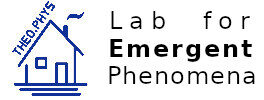PhD thesis – Anatoly Danilevich
Anatoly Danilevich
Gaussian Model and Additivity [PDF]
finished 2013-09
supervised by Klaus Mecke
Additivity is one possible generalisation of the concept of extensivity of thermodynamic quantities for finite physical systems in thermal equilibrium. This thesis concerns itself with the additivity of the Gaussian model of a ferromagnet, originally introduced by Berlin and Kac in 1952. The main focus of the thesis lies on the treatment of the next-neighbour Gaussian model on finite lattice domains in two dimensions. Given a lattice domain D ⊂ Zd, the free energy βF of an additive system at inverse temperature β can be written as
βF(D;β) = ∑sn=0fn(β) Mn(d)(D) + R(D;β), (1)
where Mn(d)(D) are the d+1 basic geometric measures of D, the so-called Minkowski functionals. In two dimensions M0(2)(D), M1(2)(D) and M2(2)(D) are the volume, the surface area and the Euler number of D , respectively. The geometric quantities Mn(d)(D) for n ≥ 1 stem from the boundary ∂D of the system and are negligible compared to the volume M0(d)(D) for infinitely large systems. The coefficients fi correspond to thermodynamic quantities like pressure, surface tension, bending rigidities, etc. and only depend on the dimension d, the temperature and the spin interaction parameters. The remaining term R decays exponentially with the system size |D| in the thermodynamic limit for non-critical temperatures. The main result of this thesis is that the additivity of the Gaussian model, i.e. Eq. (1), holds
- for convex domains D in arbitrary dimensions, see Chap. II.2. The coefficients fi are calculated explicitly analytically and discussed for d ≤ 3. For d > 3, the tools for a straight-forward calculation of the coefficients fi are laid out.
- for convex domains with an applied homogeneous magnetic field in one and two dimensions and a homogeneous boundary field in two dimensions, see Chap. II.3. The corresponding modifications of the coefficients fi are calculated. The magnetic field breaks the symmetry between the ferromagnetic and anti-ferromagnetic spin-spin coupling.
On the other hand, the additivity breaks down
- at the critical temperature and/or spin coupling strength in arbitrary dimensions, where the correlation length of the system diverges. In this case, the remaining term R in Eq. (1) is O(log |D|) instead of exponentially decaying with the system size, see Chap. II.2.
- for non-convex domains D in two dimensions. In this case, the Euler number M2(2)(D) in Eq. (1) has to be replaced with the number of convex corners of D multiplied with the coefficient f2/4 plus the number of concave corners of D multiplied with the coefficient ~f2/4. The coefficient f2 is calculated analytically, the coefficient ~f2/4 is determined numerically in Part. III. ~f2/4 is linearly independent of f0, f1, f2. All additional contributions still decay exponentially in the thermodynamic limit for non-critical temperatures and spin coupling parameters.
- for long-range spin-spin interactions. The free energy of a Gaussian spin chain with quadratically decaying spin-spin interactions features a remaining term R which decays as |D|−2 instead of exponentially, see Chap. IV.2. In general, the additivity breaks down in the presence of long-range interactions.
Furthermore the partition sum of the next-neighbour Gaussian model on triangular and hexagonal lattice types is calculated. Corresponding mathematical properties and arising difficulties are discussed in Chap. IV.1. Concluding, this thesis shows that the free energy of the next-neighbour Gaussian model in two dimensions obeys a decomposition similar to Eq. (1), although the extensive thermodynamic quantities of the model are in general not strictly additive.
